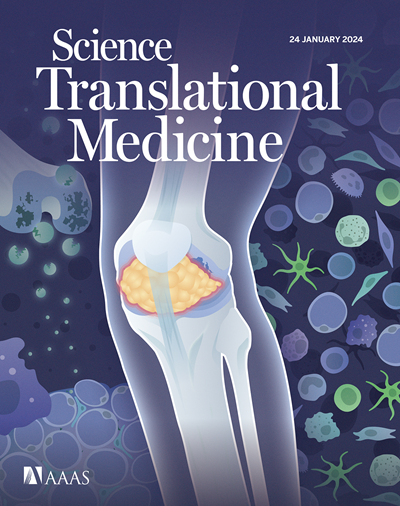足细胞特异性YAP激活通过与壁上皮细胞的串扰触发月牙状肾小球肾炎
IF 14.6
1区 医学
Q1 CELL BIOLOGY
引用次数: 0
摘要
月牙状肾小球肾炎(cGN)是一种严重的肾脏病理,其特征是上皮细胞异常增殖,导致鲍曼腔内形成月牙状。尽管具有临床意义,但参与新月形成的分子途径仍然知之甚少。鉴于足细胞所经历的机械应力可能在cGN中加剧,我们假设Hippo通路的效应物机械传感器细胞相关蛋白1 (YAP)的激活可能有助于cGN的发展。在这里,我们证明了YAP及其靶基因在肾毒性肾炎模型(一种小鼠肾毒性肾炎模型)中的激活。在机制上,转基因小鼠中YAP (YAP 5SA)的足细胞特异性过度激活导致足细胞的细胞自主肥大和壁上皮细胞(PECs)的非细胞自主激活和增殖,最终形成月牙状。在表达相同的YAP 5SA异构体的人足细胞细胞系中,转录组学分析揭示了分化的足细胞内发育程序的再激活,并确定了雷帕霉素的磷酸肌苷3-激酶-蛋白激酶b机制靶点(PI3K-Akt-mTOR)信号通路作为参与YAP诱导的足细胞肥大的候选靶点。此外,本分析发现结缔组织生长因子(CTGF)和肝素结合表皮生长因子样生长因子(HB-EGF)是yap激活的足细胞与PEC之间相互作用的潜在介质,促进PEC增生。总之,这些发现强调了YAP在cGN发病机制中的关键作用,并表明靶向YAP信号可能是治疗这种严重肾脏疾病的一种有希望的治疗策略。本文章由计算机程序翻译,如有差异,请以英文原文为准。
Podocyte-specific YAP activation triggers crescentic glomerulonephritis through cross-talk with parietal epithelial cells
Crescentic glomerulonephritis (cGN) is a severe kidney pathology characterized by the aberrant proliferation of epithelial cells, leading to crescent formation within the Bowman’s space. The molecular pathways involved in crescent formation remain poorly understood despite its clinical relevance. Given the mechanical stress experienced by podocytes, likely exacerbated in cGN, we hypothesized that activation of the mechanosensor yes-associated protein 1 (YAP), an effector of the Hippo pathway, may contribute to the development of cGN. Here, we demonstrate activation of YAP and its target genes in the nephrotoxic nephritis model, a murine model of cGN. Mechanistically, podocyte-specific hyperactivation of YAP (YAP5SA) in transgenic mice led to cell-autonomous hypertrophy of podocytes and non–cell-autonomous activation and proliferation of parietal epithelial cells (PECs), culminating in crescents. Transcriptomic profiling in a human podocyte cell line expressing the same YAP5SA isoform revealed the reactivation of developmental programs within differentiated podocytes and identified the phosphoinositide 3-kinase–protein kinase B–mechanistic target of rapamycin (PI3K-Akt-mTOR) signaling pathway as a candidate involved in YAP-induced podocyte hypertrophy. Furthermore, this analysis identified connective tissue growth factor (CTGF) and heparin-binding epidermal growth factor–like growth factor (HB-EGF) as potential mediators in the cross-talk between YAP-activated podocytes and PECs, driving PEC hyperplasia. Collectively, these findings highlight the pivotal role of YAP in the pathogenesis of cGN and indicate that targeting YAP signaling could be a promising therapeutic strategy for this severe kidney disease.
求助全文
通过发布文献求助,成功后即可免费获取论文全文。
去求助
来源期刊

Science Translational Medicine
CELL BIOLOGY-MEDICINE, RESEARCH & EXPERIMENTAL
CiteScore
26.70
自引率
1.20%
发文量
309
审稿时长
1.7 months
期刊介绍:
Science Translational Medicine is an online journal that focuses on publishing research at the intersection of science, engineering, and medicine. The goal of the journal is to promote human health by providing a platform for researchers from various disciplines to communicate their latest advancements in biomedical, translational, and clinical research.
The journal aims to address the slow translation of scientific knowledge into effective treatments and health measures. It publishes articles that fill the knowledge gaps between preclinical research and medical applications, with a focus on accelerating the translation of knowledge into new ways of preventing, diagnosing, and treating human diseases.
The scope of Science Translational Medicine includes various areas such as cardiovascular disease, immunology/vaccines, metabolism/diabetes/obesity, neuroscience/neurology/psychiatry, cancer, infectious diseases, policy, behavior, bioengineering, chemical genomics/drug discovery, imaging, applied physical sciences, medical nanotechnology, drug delivery, biomarkers, gene therapy/regenerative medicine, toxicology and pharmacokinetics, data mining, cell culture, animal and human studies, medical informatics, and other interdisciplinary approaches to medicine.
The target audience of the journal includes researchers and management in academia, government, and the biotechnology and pharmaceutical industries. It is also relevant to physician scientists, regulators, policy makers, investors, business developers, and funding agencies.
 求助内容:
求助内容: 应助结果提醒方式:
应助结果提醒方式:


